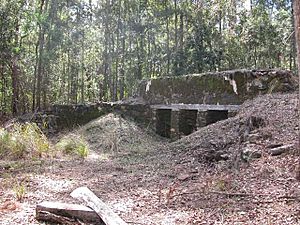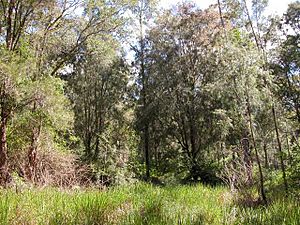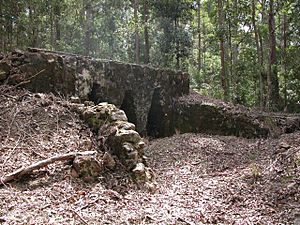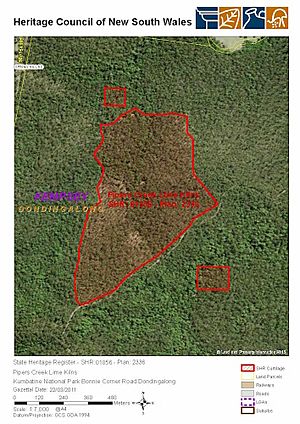Pipers Creek Lime Kilns facts for kids
Quick facts for kids Pipers Creek Lime Kilns |
|
|---|---|

Lime kiln "I"
|
|
| Location | Bonnie Corner Road, Dondingalong, Kumbatine National Park, New South Wales, Australia |
| Built | 1832–1840 |
| Owner | Office of Environment and Heritage |
| Official name: Pipers Creek Lime Kilns; Bonnie Corner Lime Kilns; Industrial Archaeological Site; Smith's Creek Lime Station | |
| Type | state heritage (archaeological-terrestrial) |
| Designated | 22 March 2011 |
| Reference no. | 1856 |
| Type | Kiln Lime |
| Category | Manufacturing and Processing |
| Builders | probably convicts |
| Lua error in Module:Location_map at line 420: attempt to index field 'wikibase' (a nil value). | |
The Pipers Creek Lime Kilns are old lime kilns located in Kumbatine National Park, New South Wales, Australia. They were built between 1832 and 1840, likely by convicts. These kilns are also known as the Bonnie Corner Lime Kilns or Smith's Creek Lime Station. Today, they are owned by the New South Wales Office of Environment and Heritage and were added to the New South Wales State Heritage Register in 2011 because of their historical importance.
Contents
History of the Pipers Creek Lime Kilns
The Pipers Creek area is part of the traditional lands of the Dunghutti people. They used the Macleay Valley for hunting and gathering food, moving between different areas depending on the season.
Europeans first saw land in the Kempsey Shire in 1770 with Captain James Cook. Later, in the 1810s, more Europeans explored the coast. In 1820, John Oxley surveyed Port Macquarie to see if it was a good place for a new convict settlement.
Why Limestone Was Important
Limestone was first found in New South Wales in 1815. It was very important for making mortar, which is like glue for bricks and stones in buildings. Early settlements needed a lot of lime for construction. Major lime-making areas grew in places like Kingsdale and Portland later on. There are over 400 places where limestone is found in New South Wales, especially in the eastern part of the state.
Port Macquarie was set up as a penal (convict) station in 1821. One main reason was to have a place far from Sydney for convicts. Also, the area had lots of timber, which was useful. Governor Lachlan Macquarie also had many convicts and needed projects for them, like building roads and new settlements.
The first buildings in Port Macquarie were simple huts. Soon, more permanent structures were built using clay bricks. Lime for the mortar came from burning oyster shells found nearby. By 1825, with big buildings like St Thomas' Church being built, a lot of lime was needed. The supply of oyster shells started to run out.
Discovery of Pipers Creek Limestone
In November 1831, a surveyor named James Ralfe found "superior quality" limestone near Pipers Creek. This was exciting because the oyster shell supply was getting low. Ralfe's discovery was marked on maps in 1833.
It's not known exactly when people started digging for limestone at Pipers Creek. However, in July 1832, Benjamin Sullivan, a magistrate in Port Macquarie, wrote a letter. He said that oyster shells for making lime were scarce. He suggested using the stone lime near Pipers Creek. He also mentioned that stone lime was better than shell lime.
Permission was given to use convict workers for lime burning, as long as it didn't cost extra money. This suggests that the lime kilns were built around the early 1830s. Lime was definitely hard to find, so people likely started using this new source quickly.
In September 1832, Magistrate Sullivan noted that the quality of the Pipers Creek lime was "uncertain." He ordered men to work on getting stone lime. It's not clear when this stone lime was first used locally. Limestone from the area wasn't sent to Sydney in large amounts until the 1840s.
Lime Production and Transport
An 1840 map shows a limestone quarry just south of Pipers Creek. A track from the quarry is also clearly marked on later maps.
In 1842, a newspaper called The Australian mentioned "Port Macquarie Stone Lime," also known as "roach lime." It said that this "desirable article" was arriving in "large and continuous supplies" in Sydney. This shows that the lime kilns were producing a lot of lime.
Geologists Carne and Jones wrote in 1919 that the limestone was burned near the quarry. Then, the lime was taken to Smith's Creek and shipped down the Maria River to Port Macquarie. They noted that parts of the old kilns were still standing. They described them as strong, rectangular structures with three fire-boxes.
Local stories suggest that a fire was set in the kiln pit with wood. Hand-quarried limestone blocks were dropped in from above. The lime would fall to the bottom and be scraped out through openings at the front. Convict workers might have lived in wooden houses near the quarry.
The land where the kilns are located was a government reserve from 1836. Private individuals were also allowed to get lime from the reserve. Kilns in the area were used whenever lime was needed in Port Macquarie, even up to the 1880s.
During the Depression of the 1930s, local sources say the kilns were used again for basic needs. In 2006, conservation work was done on Kilns I, J, and K to help preserve them.
Early Kiln Designs
The Pipers Creek lime kilns are special because they are built into a hillside. They are a type of "D Kiln," named for their D-like shape. These kilns have a stone front wall with three openings for fires. Their very narrow burning chamber is unusual. This design might have been used because long-handled iron tools were hard to find.
D Kilns became common in New South Wales in the late 1800s and early 1900s. Other types of kilns found in Australia included bottle kilns and inverted bell-shaped kilns. The oldest surviving kiln in Australia is on Norfolk Island, built in 1802.
Description of the Kilns
The Pipers Creek lime kilns are inside Kumbatine National Park. They are about 12 km south of Kempsey. You can only reach them by fire trails and then by walking. The kilns themselves are easy to see because of recent maintenance. However, other old structures nearby are often hidden by plants.
The kilns are built into hills next to where the limestone was found. They are made of rough stone held together with lime-mortar. They were once covered with a smooth layer (render) that is now peeling off.
Lime Kiln "I"
This kiln is north of Bonnie Corner Road. You get to it by a dirt track. Near the track, there are overgrown areas that might have been part of the lime kiln site. These include:
- Old brick foundations, possibly from a guardhouse.
- Stones set in mortar on a raised area.
- Grassy spots without trees.
- Shallow holes, perhaps from digging for limestone.
- Large, water-filled circular holes.
- Fallen stone walls, possibly from a cookhouse.
- A pile of small stones and gravel.
These features are hard to see and often look like natural parts of the landscape.
The kiln itself is in a clear area. There's a sign that tells you about it. The kiln is a large rectangular structure, about 8 meters long, 3.6 meters wide, and 2.4 meters high. It's built into the hillside. This design allowed smoke to escape. It's made of rough stone with lime mortar. The outer layer is peeling.
Walls at each end of the kiln (called "wing walls") hold back the hillside. This creates a flat area in front of the firing chamber. Large piles of dirt and rocks are against these walls. The fire holes at the front are three rectangular openings. They have a wooden beam (lintel) above them to support the wall. The old wooden beam is on the hill behind the kiln.
The burning chamber inside is unusually narrow, about 5.5 meters long and 1.7 meters wide, and open at the top. This allowed lime and fuel to be dropped in from the hill above. Stones inside the chamber are likely from the lime burning or have fallen from the structure. The inside of the chamber was probably lined with mortar. Some parts have been repaired recently.
There are many stones on the hill behind the kiln, likely limestone brought to be used. Weeds grow on the kiln but are regularly removed. A large block of hardened lime, about 1 meter high, is near the kiln.
Lime Kiln "J"
Kiln J is also in a clearing, accessed by a dirt track. It's built into a hill, similar in size to Kiln I. It also has wing walls at the front. It's made of rough stone with lime mortar, and its outer layer is peeling. Like the other kilns, its burning chamber is narrow and open at the top for dropping in materials. The inside was likely lined with mortar and has been repaired.
This kiln is different because it has double stone beams (lintels) over its three fire holes, instead of timber. The fire holes are arched, almost bottle-shaped. The stonework here looks more carefully built. Some plants are growing on it, but they are controlled. Several piles of lime and limestone are in front of this kiln.
Lime Kiln "K"
This D kiln is in a small clearing off a track called Convict Road. It's similar to Kilns I and J, built into a hillside and about the same size. It also has wing walls and is made of rough stone with lime mortar. The openings for the fires are made of flat stones. Its outer layer is peeling. The burning chamber is narrow and open at the top, allowing materials to be dropped in from above. A new timber beam (lintel) is above the three rectangular fire holes. Weeds are also growing here and are regularly removed. A large mound of lime, about 1 meter high, is in front of this kiln.
A fourth kiln, Lime Kiln "L," was mentioned in 2003. It was said to be west of Kiln J, built into the bank of Pipers Creek. We don't have much information about it, and it's not clear if it still exists. It was described as having two fire holes covered by silt from floods and being in poor condition.
Condition of the Kilns
As of 2010, the recent work on Kilns I, J, and K has made them stable. Visitors can now understand them better. The other old items at the site have not been worked on and are hard to see because they are hidden by plants. The site has a lot of archaeological information, which means it can teach us a lot about how the kilns worked.
Heritage Listing
The Pipers Creek Lime Kilns are very important to the history of New South Wales. They are one of the few early-to-mid 1800s lime kilns still existing in the state. They might even be a unique type of kiln. Their good condition and their history of making lime for buildings in Port Macquarie and the wider colony make them a key reminder of an important industrial process.
The Pipers Creek Lime Kilns were added to the New South Wales State Heritage Register in 2011 because they met several important criteria:
- They show the history of New South Wales: These kilns are a great example of early lime kilns in New South Wales. They show how an industry grew because more lime was needed for building permanent brick structures in Port Macquarie from 1825. They also show how lime production increased from 1840 as older lime sources ran out. The fact that they kept working, even though they were in a tough, isolated area, shows how important lime was and how hard it was to find other sources.
- They show creative or technical skill: The Pipers Creek Limekilns are technically important because they are an unusual, possibly unique, type of D-shaped lime kiln. They are built into a bank instead of standing freely. They also show how lime was burned in the 1830s in New South Wales. Their remote location reminds us of the difficult conditions faced by the workers.
- They can teach us more about history: These kilns are important for research. They are an early example of D-shaped lime kilns in New South Wales. They show how this kiln style could be changed to fit local conditions or available tools. They also show small changes in building methods over time.
- They are rare: These kilns are rare in New South Wales because there are only a few lime kilns from the early to mid-1800s still around. Their unique design also makes them special.
- They represent a type of historical place: The Pipers Creek Lime Kilns are a good example of an early version of lime kilns that became common in New South Wales later in the 1800s and early 1900s.




